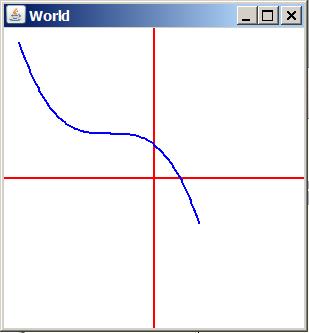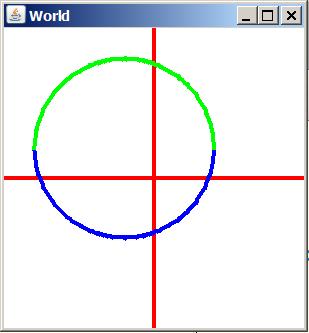| << Chapter < Page | Chapter >> Page > |
There is nothing new in Listing 8 . You should be able to correlate the code in Listing 8 and the drawing parameters in Listing 7 with the steps presented earlier to understand how the program named Parabola01 produces the output image shown in Figure 6 .
The program named Cubic01 shown in Listing 17 produces the graphic output shown in Figure 9

About the only thing that is different between the program named Parabola01 and the program named Cubic01 is the methodnamed function . In the program named Parabola01 , the method computes and returns the square of the incoming x-value. In theprogram named Cubic01 , the method computes and returns the cube of the incoming x-value. Just about everything that was said about Parabola01 also applies to Cubic01 .
There are several ways to graph all of the functions discussed in this lesson. The previous sections have illustrated only one way -- using a turtle tograph the function. I will illustrate the following two ways to graph a circle in this section and will compare some of the advantages and disadvantages of each approach :
The first approach that I will present and explain uses a turtle to graph a circle. This program is very similar to the program named Parabola01 , but there are a few differences. I will explain those differences.
The program named Circle01 shown in Listing 18 produces the graphic output shown in Figure 10 .

The first difference that is worthy of note is shown by the lines of code involving the variable named rVal in Listing 9 .
double rVal = 0.6;//radius relative to 1.0
double yVal = 0;int row = 0;
int col = 0;double xVal = -rVal;
double xInc = 2*rVal/100;turtle.setPenColor(Color.BLUE); The variable named rVal is used to specify the radius of the circle relative to a value of 1.0 as declared and initialized in Listing 9 .
In the previous sections, we have evaluated our equation for a set of 101 x values ranging from -1.0 to +1.0. For the case of the circle, we will evaluatethe equation for a set of 101 x values ranging from -rVal to +rVal . ( There is no point in evaluating the equation outside of the circle.)
The code in Listing 9 declares and initializes the variable named rVal . Further down, the code sets the initial value for xVal to -rVal . Below that, the code sets the x-increment ( xInc ) to the diameter of the circle divided by 100. This will cause the equation for the circle to beevaluated at 101 points from left to right across the circle shown in Figure 10 .
The method named function is shown in Listing 10 .
This method evaluates and returns the y-value for each incoming x-value for a circle with no offset, centered at the origin.The method evaluates the standard equation for a circle given by
radius*radius = x*x + y*y
Note that unlike the function method for Parabola01 and Cubic01 , this method requires two incoming parameters: the radius and the current x-value.

Notification Switch
Would you like to follow the 'Object-oriented programming (oop) with java' conversation and receive update notifications?